Table of Contents
Introduction
The world of software development is changing dramatically. Once the exclusive domain of seasoned programmers, application creation is now accessible to a broader spectrum of individuals. At the heart of this transformation lies low-code development, a paradigm that empowers both professional developers and citizen developers to build sophisticated applications with unprecedented speed and efficiency.
Low-code platforms have emerged as the catalysts of this revolution. By abstracting away much of the underlying code complexity, these platforms provide a visual interface that enables users to assemble applications by dragging and dropping pre-built components. This intuitive approach significantly reduces development time, allowing organizations to respond rapidly to evolving market demands and capitalize on emerging opportunities.
Demystifying Low-Code
It’s essential to dispel the misconception that low-code platforms are solely for non-technical users. While they excel at empowering citizen developers, these platforms also offer substantial benefits to professional programmers. By automating repetitive tasks and accelerating development cycles, low code frees up developers to focus on higher-value activities, such as complex algorithms and architecture design.
Furthermore, low-code platforms are not limited to simple applications. They have evolved to accommodate the creation of enterprise-grade software, capable of handling complex business logic and integrating with existing systems. However, it’s crucial to select a platform that aligns with the specific needs of your project, as not all low-code solutions are created equal.
Core Competencies of a Stellar Low-Code Platform
When evaluating low-code platforms, several key factors should be at the forefront of your decision-making process. A robust platform should possess a user-friendly interface that facilitates rapid application development without compromising on functionality. A comprehensive library of pre-built components is essential for accelerating development and ensuring consistency across applications.
Seamless integration with existing systems and data sources is another critical consideration. A low-code platform should be able to connect with databases, APIs, and other enterprise applications without undue complexity. Additionally, robust security features are paramount to protect sensitive data and comply with industry regulations.
Scalability is a fundamental aspect of a successful application. The chosen low-code platform should be capable of handling increasing user loads and data volumes as your application grows. Furthermore, support for mobile development is becoming increasingly important as more users access applications on their smartphones and tablets.
Top Low-Code Platforms for 2024
The low-code market is a dynamic landscape with numerous platforms vying for attention. To assist you in making an informed decision, we’ll delve into some of the most prominent players in the industry.
1. Mendix:

Mendix has solidified its position as a leader in the low-code space by combining rapid development capabilities with a strong emphasis on agility. Its visual modeling approach and an extensive component library make it a compelling choice for organizations seeking to build complex applications while maintaining flexibility. Mendix also excels in fostering collaboration among development teams, ensuring alignment with business objectives.
- Target Audience: Enterprises, ISVs, and developers seeking to build complex, scalable applications.
- Features: Model-driven development, cloud-native architecture, integration capabilities, AI-assisted development, mobile app development, and citizen developer tools.
- Pricing: Subscription-based, with tiers for different organizational sizes and feature sets.
- Pros: Strong focus on agility and collaboration, extensive component library, robust security features.
- Cons: Pricing can be steep for smaller organizations, learning curve for complex applications.
2. OutSystems:
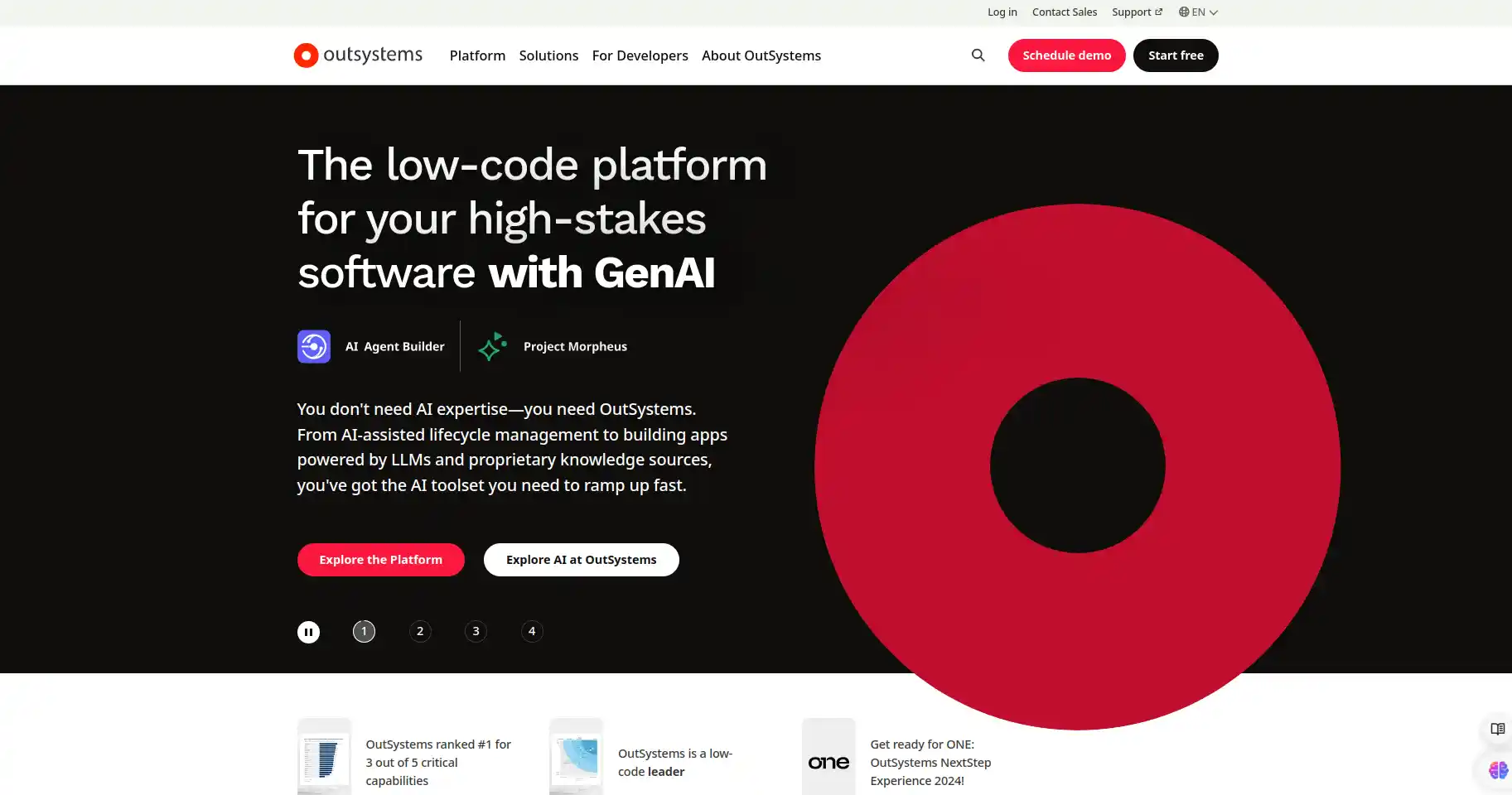
OutSystems is renowned for its ability to deliver high-performance applications with exceptional speed. With a focus on enterprise-grade features, this platform is well-suited for organizations that require robust and scalable solutions. OutSystems also integrates seamlessly with DevOps practices, enabling efficient application deployment and management.
- Target Audience: Enterprises seeking to rapidly develop and deploy high-performance applications.
- Features: Visual development, AI-powered development, mobile and web app development, integration with DevOps tools, and advanced analytics.
- Pricing: Subscription-based, with multiple tiers to accommodate different needs.
- Pros: Excellent for building complex enterprise applications, strong focus on DevOps, high-performance capabilities.
- Cons: Pricing can be premium, learning curve for some features.
3. Appian:
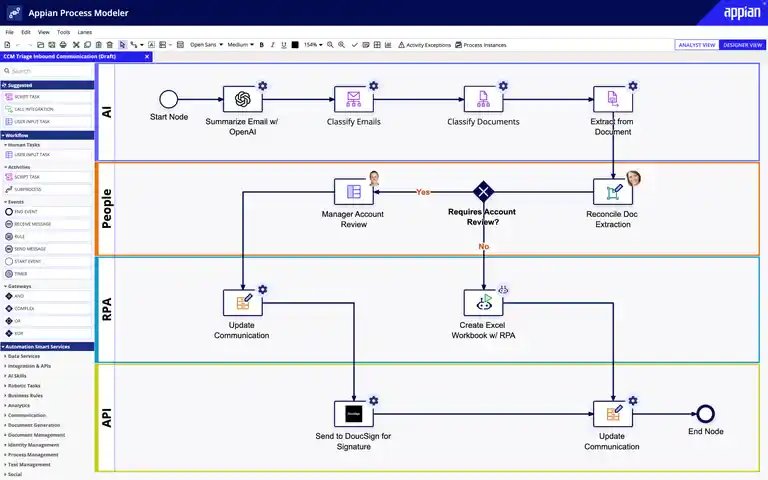
Appian is a low-code powerhouse specializing in process automation. By streamlining workflows and eliminating manual tasks, Appian empowers organizations to achieve operational excellence. Its combination of low-code development and process automation capabilities makes it an ideal choice for businesses seeking to enhance efficiency and productivity.
- Target Audience: Enterprises focused on process automation and digital transformation.
- Features: Low-code development, workflow automation, robotic process automation (RPA), case management, and AI-powered decisions.
- Pricing: Subscription-based, with various pricing models depending on deployment options and features.
- Pros: Powerful process automation features, strong focus on compliance and governance, AI-driven insights.
- Cons: Pricing can be a complex, steep learning curve for complex automation projects.
4. Microsoft PowerApps:

Leveraging the strength of the Microsoft ecosystem, PowerApps offers a familiar experience for users accustomed to Office 365. Seamless integration with other Microsoft tools is a key advantage for organizations already invested in the Microsoft stack. PowerApps strikes a balance between simplicity and functionality, making it accessible to both citizen developers and professional programmers.
- Target Audience: Organizations heavily invested in the Microsoft ecosystem, seeking to build custom applications.
- Features: Drag-and-drop interface, integration with Office 365, Power Automate, and Azure, mobile app development, and AI capabilities.
- Pricing: Per-user or per-app licensing, with various tiers based on features and usage.
- Pros: Familiar interface for Microsoft users, an extensive ecosystem of connectors, cost-effective for smaller projects.
- Cons: Limitations in customization for complex applications, and potential performance issues with large-scale apps.
5. Zoho Creator:
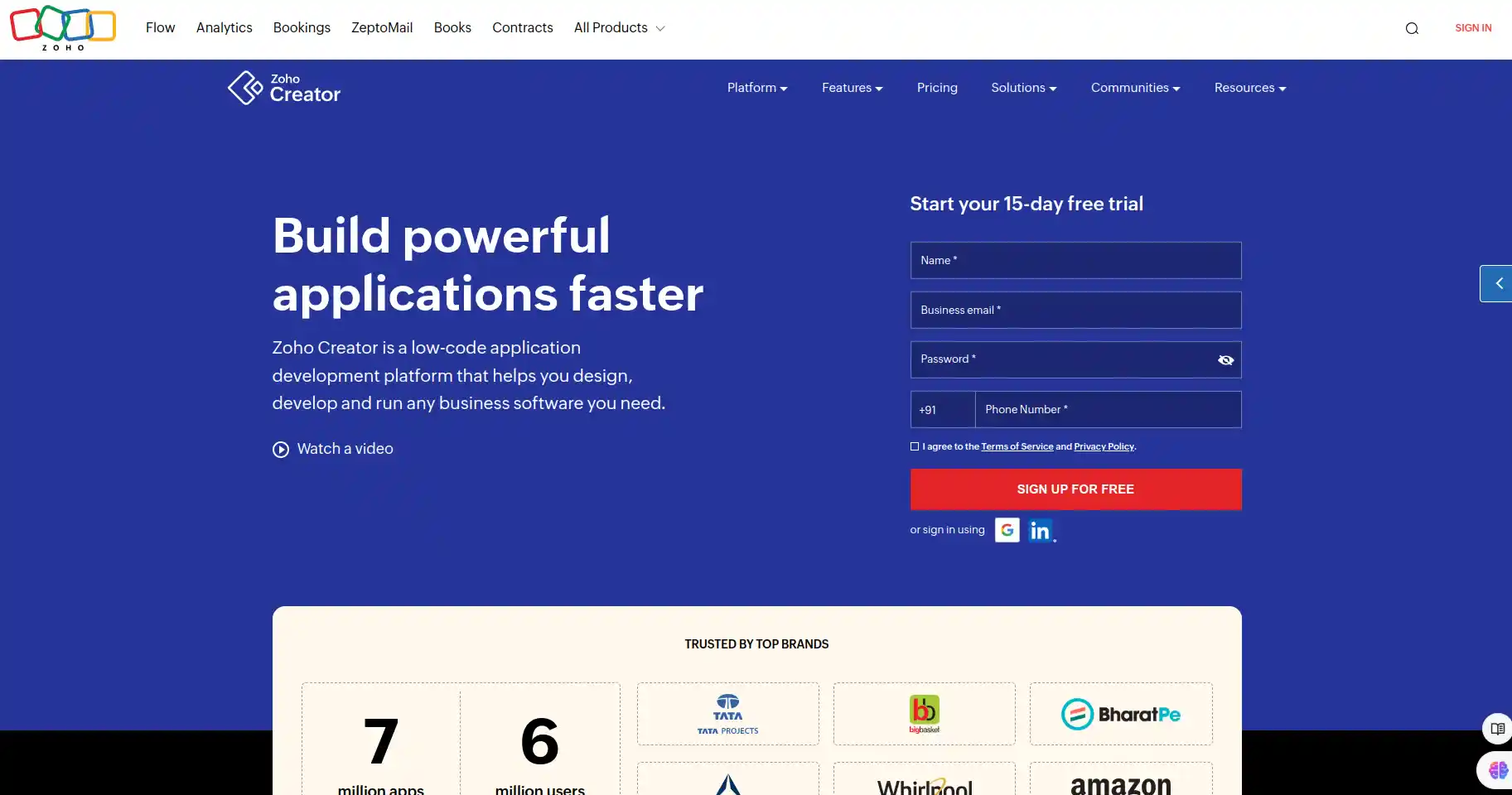
Zoho Creator stands out for its versatility and affordability. This low-code platform offers a wide range of features, from CRM and project management to custom application development. Its comprehensive suite of tools and competitive pricing make it an attractive option for small and medium-sized businesses.
- Target Audience: Small and medium-sized businesses seeking a versatile and affordable low-code platform.
- Features: Database management, workflow automation, mobile app development, reporting and analytics, and integration with other Zoho applications.
- Pricing: Subscription-based, with multiple tiers offering different features and user limits.
- Pros: Cost-effective, comprehensive feature set, suitable for a variety of applications.
- Cons: Limited scalability for large-scale enterprise applications, potential performance limitations compared to enterprise-grade platforms.
Related Article: Unleashing Creativity and Efficiency: The Rise of Low-Code and No-Code Development
6. GeneXus:
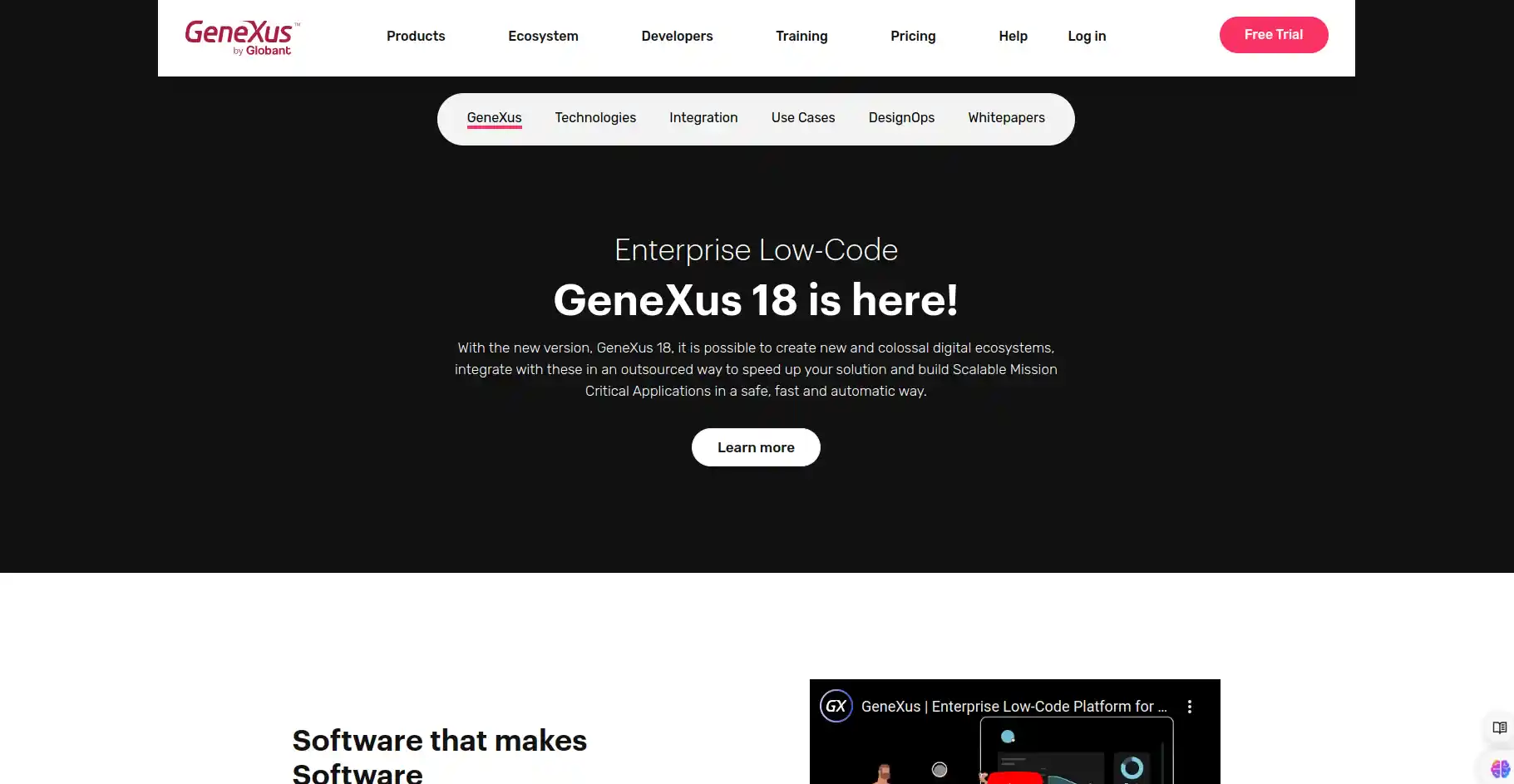
GeneXus is an intelligent low-code platform designed for enterprise-scale applications. It leverages AI to automate development tasks and generate code across multiple platforms.
- Target Audience: Large enterprises seeking to build complex, mission-critical applications.
- Key Features: AI-driven development, multi-experience development (web, mobile, and desktop), integration with legacy systems, and rapid application development.
- Pricing: Contact GeneXus for pricing information.
- Pros: Powerful AI capabilities, ability to handle complex enterprise applications, strong focus on multi-experience development.
- Cons: There is a steep learning curve, pricing can be high, limited customization options for some users.
7. QuickBase:
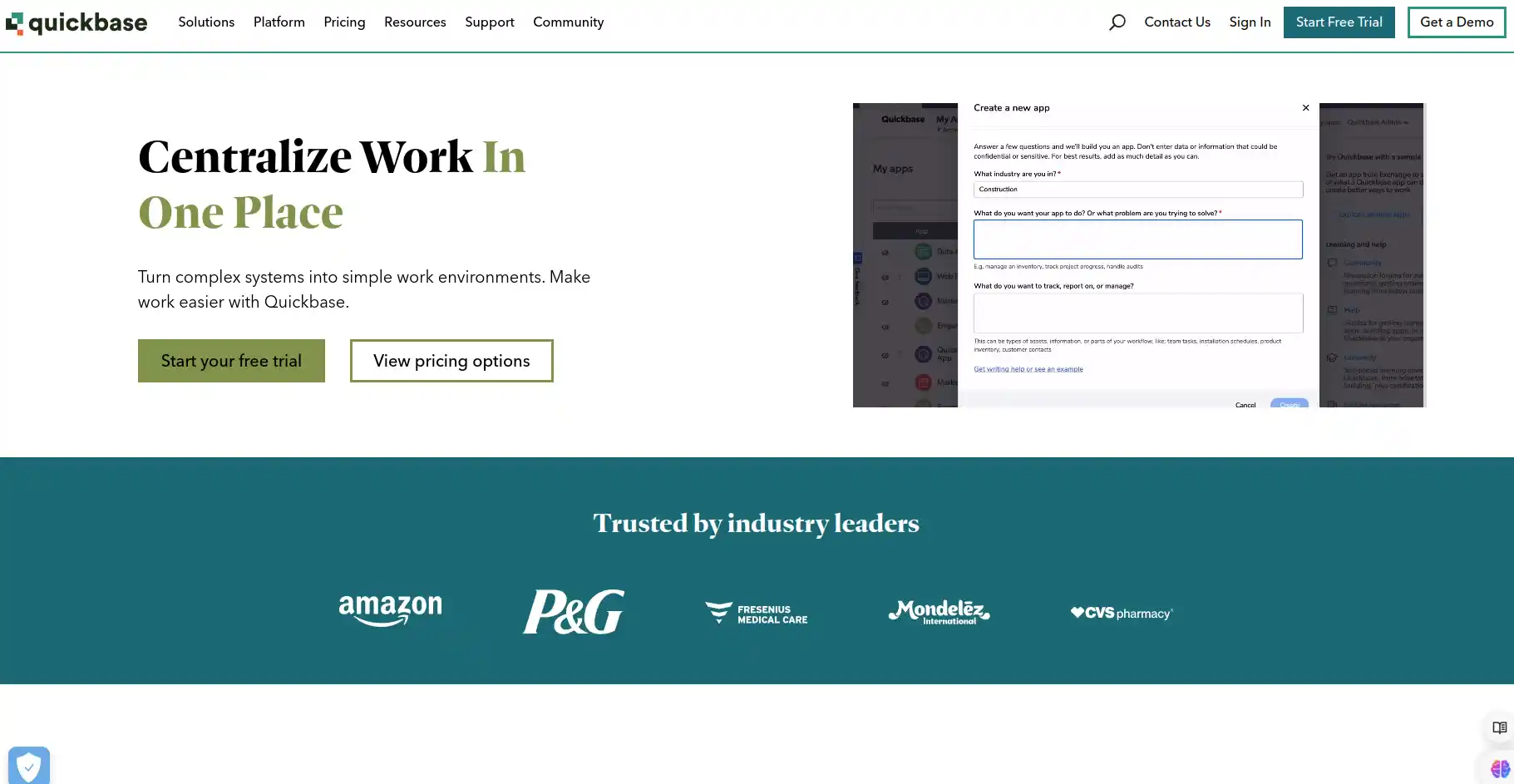
QuickBase offers a flexible platform that caters to both no-code and low-code developers. It provides a visual interface for building applications and integrates with various data sources.
- Target Audience: Businesses of all sizes seeking to build custom applications without extensive coding.
- Key Features: No-code application builder, low-code development capabilities, integration with various data sources, and workflow automation.
- Pricing: Starts at $20 per user per month.
- Pros: Easy to use, flexible platform for different skill levels, affordable pricing.
- Cons: Limited customization options for complex applications, fewer advanced features compared to some competitors.
8. Creatio:

Creatio is a low-code platform focused on sales, marketing, and service automation. It offers pre-built modules and a visual interface for rapid application development.
- Target Audience: Businesses seeking to improve sales, marketing, and customer service operations.
- Key Features: CRM capabilities, marketing automation, sales process automation, and low-code application development.
- Pricing: Contact Creatio for pricing information.
- Pros: Strong focus on sales, marketing, and service automation, pre-built modules for rapid deployment, and user-friendly interface.
- Cons: Limited customization options for non-core business processes, pricing can be high for some features.
9. Kintone:
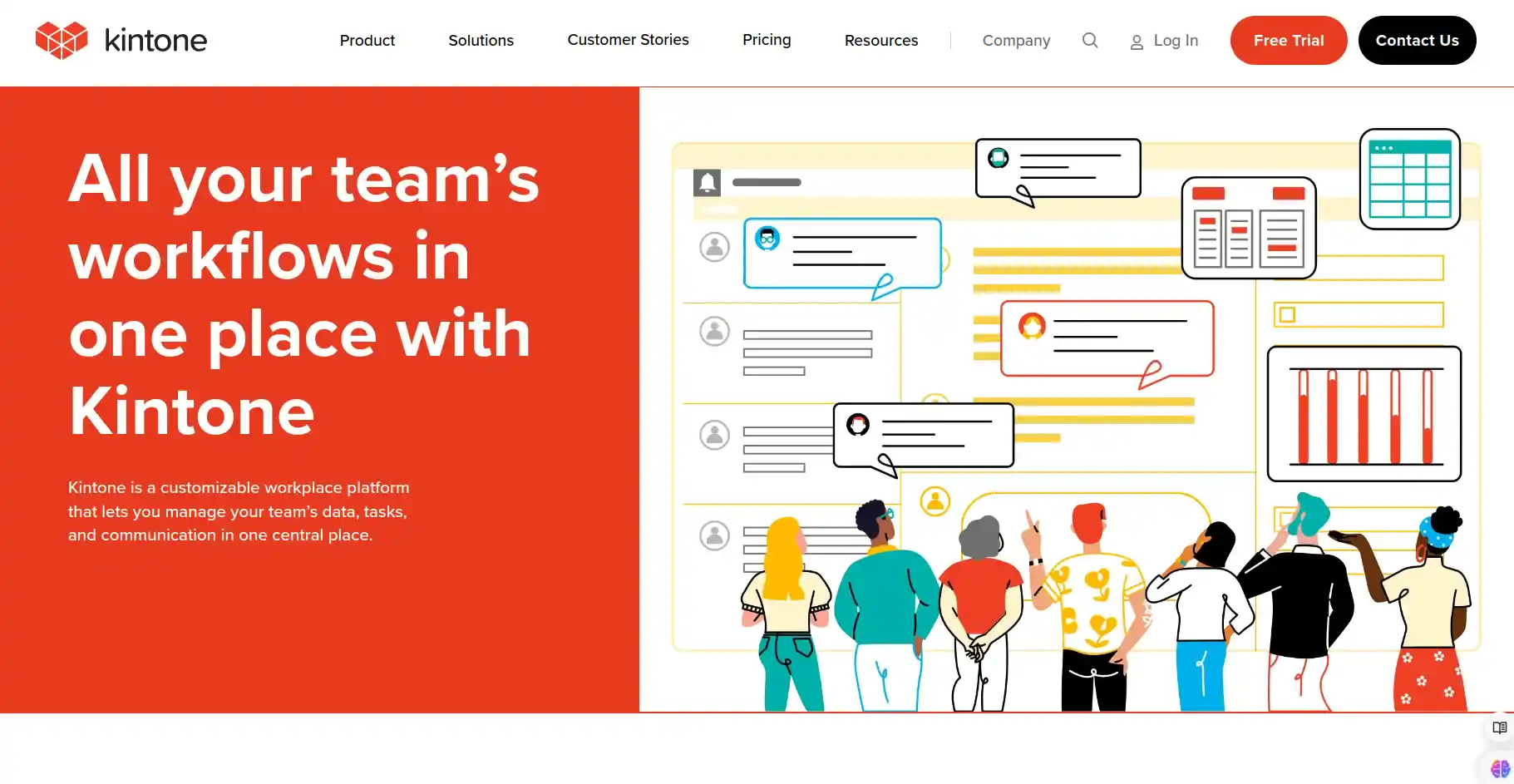
Kintone is a collaborative low-code platform that enables teams to build custom applications together. It emphasizes real-time collaboration and data sharing.
- Target Audience: Teams seeking to build collaborative applications and streamline workflows.
- Key Features: Real-time collaboration, data sharing, mobile app development, and integration with various systems.
- Pricing: Starts at $10 per user per month.
- Pros: Strong focus on collaboration, easy to use, affordable pricing, suitable for various departments.
- Cons: Limited customization options for complex applications, and fewer advanced features compared to some competitors.
10. Betty Blocks:

Betty Blocks is a low-code platform designed for building enterprise-grade applications. It offers a comprehensive set of features and a focus on scalability.
- Target Audience: Enterprises seeking to build complex, scalable applications.
- Key Features: Visual development, integration with various systems, cloud-native architecture, and enterprise-grade security.
- Pricing: Contact Betty Blocks for pricing information.
- Pros: Scalability, strong focus on enterprise-grade applications, comprehensive feature set.
- Cons: Steep learning curve, high pricing, and limited customization options for some users.
11. Inceptmvp
InceptMVP is a certified development partner specializing in no-code and low-code solutions, utilizing platforms like Bubble.io and FlutterFlow to create scalable web and mobile applications. They offer a range of services, including app development, design, prototyping, and ongoing maintenance.
- Target Audience: Startups, small to medium businesses, and enterprises seeking custom app development without extensive coding.
- Key Features: End-to-end development, design, rapid prototyping, maintenance services, and focus on scalability with no-code/low-code platforms like Bubble.io and FlutterFlow.
- Pricing: Customized, based on project requirements.
12. Appsmith
Appsmith is one of the leading open-source platforms for building internal tools, offering a balance of simplicity and scalability. Its drag-and-drop interface, paired with robust integration options, makes it a popular choice for developers and enterprises aiming to create custom applications quickly. Appsmith also emphasizes developer productivity by enabling seamless API integrations and database connections, fostering collaboration between technical and non-technical teams.
- Target Audience: Startups, Enterprises, and developers focusing on internal tools and dashboards.
- Features: Open Source, extensive integration capabilities,drag-and-drop UI builder, custom widgets, cloud or self-hosted deployment, role-based access control (RBAC).
- Pricing: Appsmith offers a free open-source core, a Business Plan at $15/user/month, and an Enterprise Plan starting at $2,500/month for 100 users.
- Pros: Allows for extensive customization, emphasizes connectivity with various data sources and services, facilitates rapid development with its drag-and-drop features.
- Cons: Complex applications might require performance optimizations.
A Diversified Low-Code Ecosystem
While the aforementioned platforms have garnered significant attention, the low-code market is far from saturated. Several other platforms offer unique value propositions and cater to specific use cases.
- Appsmith: As an open-source low-code platform, Appsmith provides developers with unparalleled flexibility and control. Its customizable architecture and active community make it a compelling choice for those seeking a highly tailored solution.
- Bubble: With a focus on web application development, Bubble offers a visual interface for creating dynamic and interactive experiences. Its ease of use and powerful features have made it a popular choice among startups and entrepreneurs.
- Nintex: Specializing in workflow automation and process management, Nintex enables organizations to optimize their operations through low-code solutions. Its deep integration with Microsoft platforms makes it a strong contender for businesses utilizing the Microsoft stack.
Key Considerations
Selecting the optimal low-code platform requires a careful assessment of your organization’s specific needs and constraints. Several factors should influence your decision:
- Development team expertise: Evaluate the technical skills of your team to determine the level of coding required and the complexity of the platform that can be effectively utilized.
- Application complexity: Assess the complexity of the applications you intend to build. Some platforms are better suited for simple applications, while others can handle enterprise-scale systems.
- Scalability: Consider the potential growth of your applications and ensure the platform can accommodate increasing user loads and data volumes.
- Integration capabilities: Evaluate the platform’s ability to connect with existing systems and data sources to avoid integration challenges.
- Cost: Compare pricing models and consider the total cost of ownership, including licensing, deployment, and maintenance expenses.
The Low-Code Future
Low-code platforms are undeniably reshaping the software development landscape. By democratizing application development and accelerating time-to-market, these platforms empower organizations to innovate at unprecedented speeds. As technology continues to advance, we can anticipate even more sophisticated and powerful low-code solutions emerging in the future.
Embracing low code is no longer a choice but a necessity for businesses seeking to remain competitive in the digital age. By carefully selecting the right low-code platform and leveraging its capabilities, organizations can unlock new opportunities, enhance operational efficiency, and drive business growth.
Conclusion
The era of low-code development has ushered in a new frontier of possibilities for businesses and developers alike. By harnessing the power of these platforms, organizations can accelerate innovation, streamline operations, and gain a competitive edge.
We’ve explored a diverse range of low-code platforms, each with its own strengths and target audience. The key to selecting the ideal platform lies in a comprehensive evaluation of your specific needs, development team expertise, and desired application complexity.
As the low-code landscape continues to evolve, it’s imperative to stay informed about emerging trends and advancements. By embracing this transformative technology, you’ll position your organization for success in the digital age. Remember, the journey to low-code mastery starts with taking the first step. So, embark on your exploration, experiment with different platforms, and unlock the full potential of low-code development.